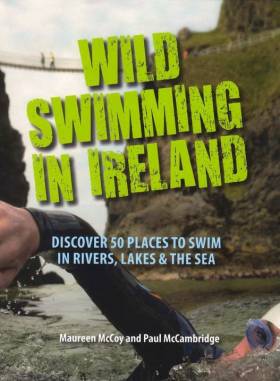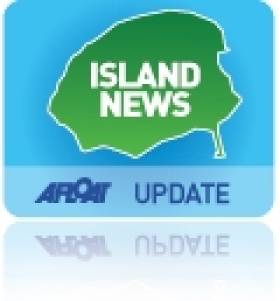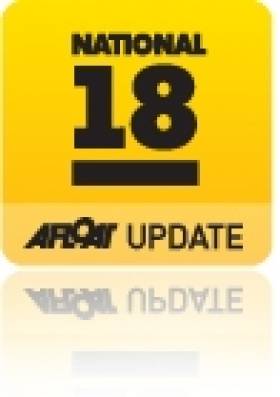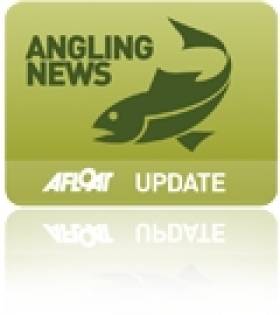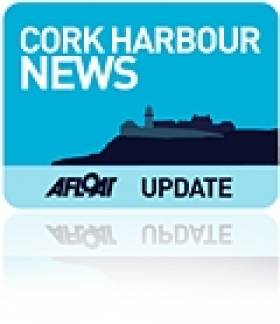Displaying items by tag: book
New Guide to Irish Swimming Places Will Support the RNLI
A Little Book of Happy Swimming Locations is a new guide to some of the hidden gems and well-known spots ‘for taking a dip’ all around Ireland.
Launched last month, this is the second book on the theme by open water swimmer Catherine Mulcahy. In 2021 her first book, A Little Book of Swimming Happiness, was a great success and raised over €10,000 for the RNLI.
Speaking of her love for open water swimming, the author says: “As long as I remember I have loved the sea. My mother initially introduced me to sea swimming at The Strand when I was a toddler, a local swim spot near our family home in Cork. This ‘grá’ for the sea has since evolved into a genuinely unconditional love!”
A Little Book of Happy Swimming Locations celebrates swimming around Ireland and features 50 contributors favourite swim spots.
The book is beautifully presented with photographs and commentary from swimmers who share their favourite swimming spots with the readers.
The book has a cover price of €20 with 100% of the proceeds going to the RNLI. It is available online from Nourish at and also available to purchase in-store in south Co Dublin at 64 Wine and Cavistons in Glasthule village and Cafe du Journal in Monkstown. All stockists are selling the book at 0% commission.
Ireland's Lighthouses is Focus of New Aerial Photography Book
Red Stripe Press has published Ireland’s Guiding Lights: Celebrating Our Lighthouses by Dennis Horgan, Gerald Butler and Tim McCarthy, a book full of aerial photography and rich stories from one of Ireland’s most celebrated lighthouse historians.
Ireland has a rich maritime heritage, and lighthouses have played a significant part in our history.
These unique structures ring our coast, providing safe passage for all those who sail our coastal waters, from mammoth ocean-going tankers to leisure craft and fishing vessels. Despite the advances in GPS technology, our lighthouses provide a permanent guiding presence by day and night.
Aerial photographer Dennis Horgan has spent many hours in light aircraft flying around the entire island of Ireland, capturing stunning images of these coastal sentinels from a rarely seen perspective.
Alongside these images, former Irish Lights keeper and lighthouse historian Gerald Butler contributes some fascinating insights into these lights and the dedicated people who manned them.
With a foreword by the chairman of the Commissioners of Irish Lights, Ireland’s Guiding Lights will appeal to all who have an interest in our coastal lighthouses.
Ireland’s Guiding Lights is available now from all good bookshops, www.redstripepress.com and www.dennishorgan.ie for €24.99.
New Book Celebrates Wild Swimming In Ireland
#WildSwimming - Wild Swimming in Ireland is a new book of photography showcasing some of the most breathtaking locations to take a dip around the island, as the Banbridge Leader reports.
Compiled by open sea swimmer Maureen McCoy and photographer Paul McCambridge – a noted open-water swimmer himself – the book, which features 50 spots for wild swimming, is hoped to be just the beginning of a series highlighting the charms and even therapeutic qualities of swimming beyond the usual beaches and pools.
From seaside spots like beneath the Carrick-a-Rede rope bridge in Co Antrim to the islands of Lough Erne and quiet countryside river stretches, McCoy and McCambridge hope the book provides inspiration for prospective wild bathers of every stripe and swimming ability.
The Banbridge Leader has more on the story HERE.
Second Edition For Book Chronicling Ireland's Coastal Islands
#Islands - Sea kayaking enthusiast David Walsh has published a second edition of Oileáin, his popular pictorial guide to Ireland's coastal islands, as TheJournal.ie reports.
Now featuring some 574 islands - 503 of which the author has personally landed upon - the book's selection runs from the easily accessible, such as Ireland's Eye off Howth, to the rugged and remote, like the infamous Fastnet Rock south of the Cork coast.
While Walsh provides practical advice for how readers can themselves lands on even the most challenging of these islands, the book has equal appeal to anyone curious about the many islands, big and small, that stud the Irish coastline.
TheJournal.ie has more on the story HERE.
National 18 Book Launch In Cork Tonight
#National18 - Here's a reminder for your diary that the official book launch of Brian Wolfe's history of the National 18 will take place tonight (11 December 2013) at 7.30pm at the Royal Cork Yacht Club.
The book documents 75 years of the boat's legacy on Irish waters, from its timber beginnings in the late 1930s to the fibreglass developments three decades on, with some 800 images across its more than 200 pages.
Wolfe has also painstakingly researched and compiled all of the boats championships and sailors across the Ireland and the UK, making this book a must for any sailor's library.
And with the gift-giving season in mind, the book is available in a limited collectors' hardback edition of just 378 copies, signed by the author, priced at €55 (plus P&P) - 378 being the number of boats registered in the history of the class.
Wolfe will be joined tonight at the launch reception by Eithne Payne and renowned marine writer Tom MacSweeney.
New Book Charts History Of Arklow RNLI
#RNLI - The history of Arklow's lifeboat station from 1826 to the present is recounted in a new book to be published this coming November.
To the Banks & Beyond is written by renowned local writer and historian Jim Rees, who put the project together over a number of years.
A limited run of very collectable hardback copies of the book is being made available for booking prior to the launch, and Arklow RNLI's fundraising branch committee is now inviting presages.
Only 100 copies will be printed at a cost of €25 plus P&P, though a paperback edition (€15 plus P&P) will also be produced. Orders can be placed by contacting Arklow RNLI at [email protected] or via Facebook, or by calling Tony Fennell at 086 256 9787 or Tom Nolan at 086 161 2037.
The book will also be available from Dee-Jay Publications.
Atlantic Salmon Trust Launches 2012 Auction Online
#ANGLING - The Atlantic Salmon Trust's 2012 Fishing Country Sports Auction went live this week, with some 300 lots offered - including three prime Irish fishing spots on the Blackwater, Mourne and Drowes.
“The annual auction remains our single most significant fundraising event and its success is essential to helping us continue our work,” said AST chief executive Tony Andrews in The Irish Times.
Aside from top fishing opportunities in England, Scotland and Wales, spots in Russia are also featured, as well as deer stalking excursions and shooting days.
For art lovers, sporting prints and watercolours are included in the lots, as is a limited edition of the acclaimed Atlantic Salmon Magic, and Salmon Rivers, one of the best recent publications on the Atlantic salmon. They could be the perfect gift for someone's Valentine's Day.
Bids will close on 14 February for the online auction at www.atlanticsalmontrust.org/auction/.
Wogan's Visit to Cape Clear Island
#ISLANDS - Cape Clear Island's most well-known couple may get even wider attention now that they're featured in Terry Wogan's new book on Ireland.
Micheál and Sile Ó Ceadagáin – who were the focus of TG4 programme Mí na Meala – are two of the many characters included in Wogan's Ireland, the book accompanying the legendary broadcaster's recent TV series.
According to the blog of the Cape Clear ferry service Cailín Óir: "The photographs [included] are stunning, including those of Cléire and Fastnet, to where Terry enjoyed an idyllic summer’s outing with Micheál on his boat The Gaisceannán.
"Micheál and Sheila are a hospitable couple which extends to the boat and Micheal's famous teas served at sea have pleased many, including the indefatigable Terry."
Wogan's Ireland is packed with photos and stories of Terry's whistle-stop tour of the country's 'coastal fringe', laced with his self-deprecating wit. The book is available online for as little as €10.
New Book on Cork Documents Development of Harbour City
#CORK HARBOUR - A never-before-seen collection of images and memorabilia from Cork celebrating the harbour city and its heritage has just been published, the Cork Independent reports.
Pure Cork features photos, postcards, maps and other items collected by Blarney Street native Michael Lenihan over the last 40 years, and he claims that "95 per cent" of them have never been seen before.
The selection represents just a fraction of the more than 2,000 postcards and countless photographs in Lenihan's collection.
From paddle steamer boats in the famous harbour to the landing of the first plane at Cork Airport in the 1960s, the changing face of transport in the city is also documented.
Pure Cork is available in bookshops across Cork, priced at €25. An exhibition of original photos from Lenihan's collection is also on display at Liam O'Shea's Bookshop on Oliver Plunkett Street.
The Cork Independent has more on the story HERE.
New Titanic Book Tells Her Story In Photographs
Titanic In Photographs by Daniel Klistorner, Steve Hall, Bruce Beveridge, Art Braunschweiger and Scott Andrews is the story of Titanic in pictures, from build to tragic maiden voyage. It will be Published in October 2011. This £20 hardback follows the story to inevitable conclusion.
The name Titanic has become synonymous with catastrophe, the story of this luxurious liner legendary. Wrecked after colliding with an iceberg on her maiden voyage, the loss of around 1,500 lives among her passengers and crew has gone down in history as one of the most emotive and tragic disasters in history.
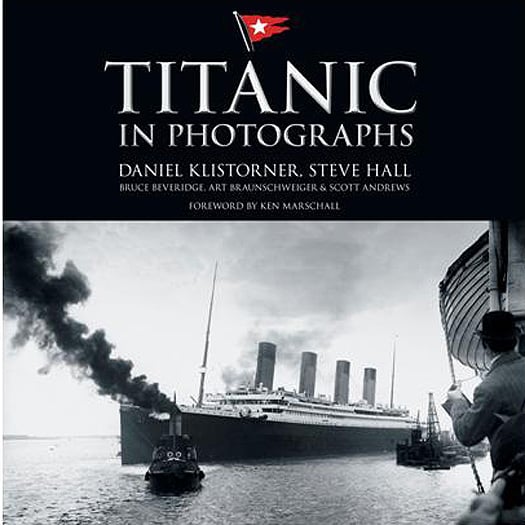
The new book on the Titanic will sell for £20
Titanic In Photographs tells her full story, from the shipyards of Harland & Wolff and its early vessels, with the backdrop of the great race to build the biggest and best passenger liner, to the frenzy of excitement surrounding her launch. Looking at her officers and crew, as well as her stops at Cherbourg and Queenstown the photographs follow the story to its inevitable conclusion, considering the lifeboats, the presence of the Carpathia and the aftermath of the shattering disaster.
• Commemorating 100 years of Titanic.
• Stunning images, including many rare photographs from collectors' archives.
• Written by five of the foremost Titanic experts in the world.
Daniel Klistorner is the world's foremost expert on Titanic's passenger accommodations and has consulted to the media, auction houses and museums around the world. Steve Hall, a renowned Titanic visual historian, has collected, studied and researched the ships photographic record for over three decades. Bruce Beveridge is one of the foremost authorities on Titanic's exterior and general working arrangements, and, with Scott Andrews, is a recognised authority on the technical aspects of her layout and construction. All four, along with Titanic modeller and researcher Art Braunschweiger, previously wrote TITANIC: The Ship Magnificent, the most comprehensive book published on Titanic to date.
Titanic In Photographs by Daniel Klistorner, Steve Hall, Bruce Beveridge, Art Braunschweiger, & Scott Andrews is the story or Titanic in pictures, from build to tragic maiden voyage. Published October 2011, this £20 hardback follows the story to inevitable conclusion.



























